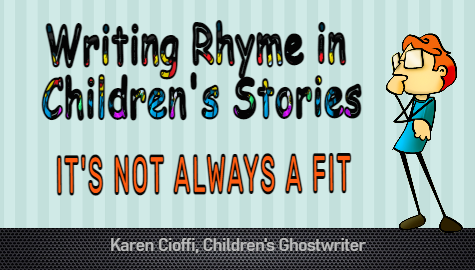Rhyming, when done right, is a wonderful way to engage children.
Children, as soon as they’re able, love to rhyme words . . . and this can begin as early as two-years-old: cat-hat, mouse-house.
But to write a rhyming story . . . a well written rhyming story . . . is difficult. You need a good story, rhyme, rhythm/beat, meter, stresses, and more—all this in addition to the already unique rules and tricks in writing for children. And some writers just don’t have that innate ability to write rhyme well.
But don’t let this discourage you or stop you; writing ‘good’ rhyme can be learned.
According to Delia Marshall Turner, Ph.D., the elements of poetry are: voice; stanza; sound; rhythm; figures of speech; and form.
Voice (the speaker)
Stanza (the format of lines grouped together)
Sound (rhyme and other patterns)
Rhythm (the beat and meter – the pattern of stressed and unstressed syllables)
Figures of Speech (types of figurative language)
Form (the type of poem, its design)
Along with this there is perfect rhyme, and approximate rhyme:
Perfect rhyme: tie/lie; stay/day
Approximate rhyme: top/cope; comb/tomb
And, there are many more bits and pieces that go into writing poetry/ rhyme. But, the foundation that holds your rhyming story all together is the story itself—you need a good story, especially when writing for children.
Another great source of rhyming information is the article, “To Rhyme or Not to Rhyme” by Dori Chaconas, in the Writer Magazine, October 2001: “You may write in perfect rhyme, with perfect rhythm, but if your piece lacks the elements of a good story, your efforts will be all fluff without substance. I like to think of story as the key element, and if the story is solid, and conducive to rhyme, the rhyme will then enhance the story.”
This is a wonderful explanation because it mentions “if the story is solid, and conducive to rhyme.”
That IF in the quote above means that not all stories will work in rhyme, and the writer needs to know whether his will or will not.
So, if you’re interested in writing in rhyme, take the time to learn to do it right.
There are a number of sites and articles online that can help. There are also books available, as well as classes you can take. Do a Google search for the tools that are right for you.
Two great places to start your search is at:
http://www.underdown.org/mf-rhyme-and-meter.htm
http://www.writingrhymeandmeter.com/
MORE ON WRITING FOR CHILDREN
Striving to Be a Better Writer by Writing More
Book Marketing – You’ve Gotta Have a Blog
Writing, Submissions, and Working with Editors
I’m a working children’s ghostwriter, editor, and coach. I can help turn your story into a book you’ll be proud to be the author of, one that’s publishable and marketable.
OTHER HELP I OFFER:
FICTION WRITING FOR CHILDREN COURSE
A guided self-study course and mentoring program.
HOW TO WRITE A CHILDREN’S FICTION BOOK
A DIY book to help you write your own children’s book.
WRITERS ON THE MOVE PRESS.
Self-publishing help for children’s authors.
You can contact me at: kcioffiventrice@gmail.com. Or give me a call at 347—834—6700. (Please leave a message- I’ll get back to you as soon as I can.)



3 thoughts on “Rhyme in Children’s Stories – It’s Not Always a Fit”